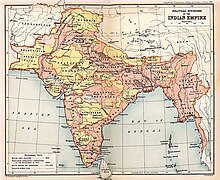The divisions of British India were the administrative divisions of the Government of the British Raj or the Indian Empire.[1]

Divisions in Bengal
editThe seven Bengal Regulation Districts were named as 'divisions' in 1851:
- Jessore Division, area 14,853 sq mi, population 5,345,472 (1851)
- Bhagalpur Division area 26,464 sq mi, population 8,431,000
- Cuttack Division, area 12,664 sq mi, population 2,793,883
- British division (Moorshedabad), area 17,556 sq mi, population 6,815,876
- Dacca Division, area 20,942 sq mi, population 4,055,800
- Patna Division, area 13,803 sq mi, population 7,000,000
- Chittagong Division, area 7,410 sq mi, population 2,406,950
The partition of Bengal in 1905 , there were seven divisions in Bengal :
- Presidency Division
- Burdwan Division
- Patna Division
- Bhagalpur Division
- Tirhut Division
- Chota Nagpur Division
- Orissa Division(Cuttack)
After the reunited of Bengal in 1911, the boundaries of Bengal were changed and the Bengal were divided five divisions . viz :
Divisions of Eastern Bengal and Assam
editThe divisions of Eastern Bengal and Assam Province 1905—1912:
Divisions in Baroda
editDivisions in Bombay
editDivisions in Burma
editDivisions in Central India
editDivisions in Central Provinces and Berar
editDivisions of Hyderabad
edit- Aurangabad Division
- Gulbarga Division
- Gushanabad Division (Medak Division)
- Warangal Division
Divisions in Rajputana
editDivisions in United Provinces
edit- Meerut Division
- Agra Division
- Bareilly Division
- Allahabad Division
- Benares Division
- Gorakhpur Division
- Kumaun Division
- Jhansi Division
- Lucknow Division formerly also Sitapur Division
- Faizabad Division (Fyzabad Division)
Divisions in Punjab
editSee also
editReferences
edit- ^ Imperial Gazetteer of India. Published under the authority of His Majesty's Secretary of State for India in Council. Oxford: Clarendon Press, 1907-1909
External links
edit